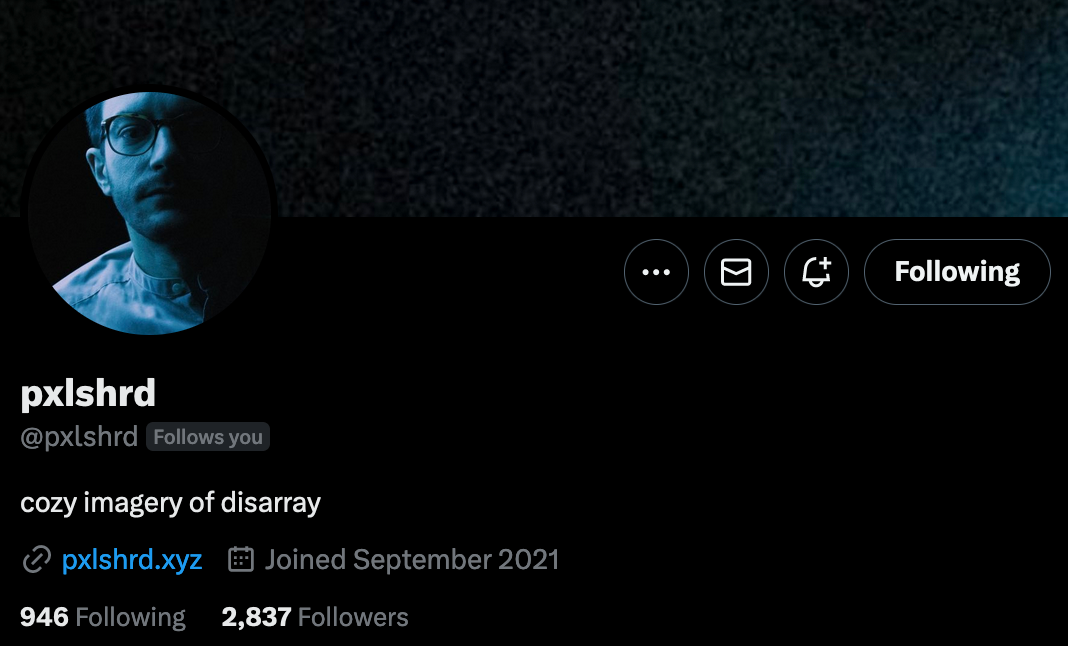Pxlshrd is a sound engineer and musician turned generative artist. With a deep love for music and sound, pxlshrd draws most of his inspiration from an audible realm, subsequently translating his ideas onto the digital canvas by means of code. Having created an impressive number of generative pieces on fx(hash) - he's become a prolific artist in the space.
You might better know pxlshrd as the creator of "Breeding Grounds" and the more recent "Rückkopplung" that was released in conjunction with Tender. After seeing the stunning outputs of Rückkopplung I reached out to pxlshrd asking if he'd be up to have a chat with me - and reading these words, you can probably tell what his answer was.
We instantly connected over a shared interest and love for music, having started out with generative art in a similar manner - a means to create visualizations for our musical endeavors. We spent a large portion of our conversation talking about the importance of music to him, and how it's become an integral part of his process. Furthermore we talk about the stellar Rückkopplung, the story of it's inception and the message that it tries to convey. Lastly we also touch upon the difficult topic of valuing art and what effects it has on the artistic process.
That said, thank you pxlshrd for the time and conversation - here goes the conversation.
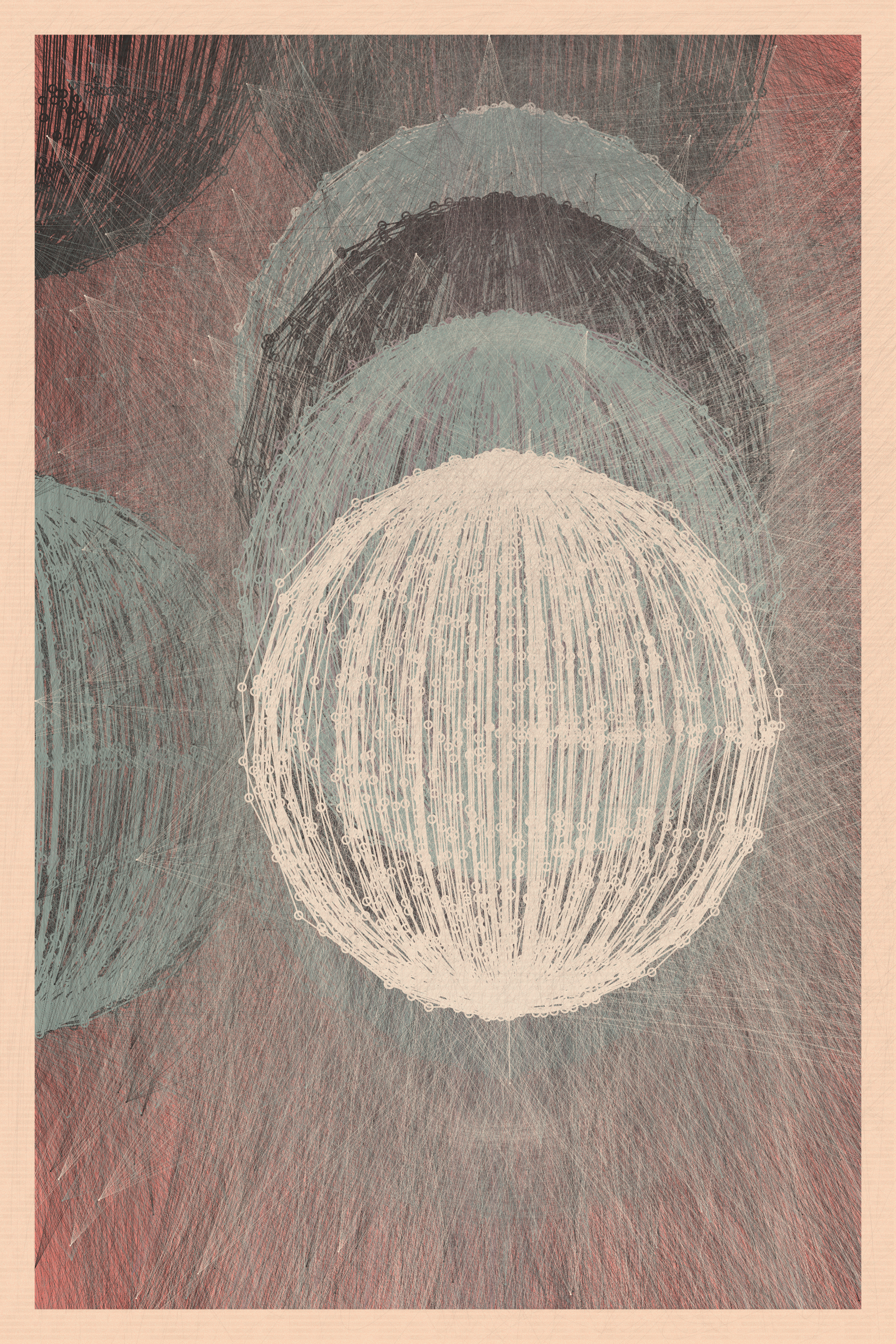
Background
Gorilla Sun: A short while after you had released your generative token collaboration with Mikkel Hartmann "Pause", you were invited to be on the Arbitrarily Deterministic podcast. In the episode you mention that prior to getting into generative art and the NFT space you had a long career as a sound engineer. How did you make the transition to generative art?
pxlshrd: By profession, I'm a sound engineer, and I've been making music since I was 12 - besides that I've also done photography and graphic design in parallel.
When the pandemic started, it was a turning point in my life. I told myself that I'd use this break to get rid of all the things that I didn't want to do anymore - sometimes when you're doing live sound for a show you end up with 16-hour days, and that was just a bit too much for me.
Just like you I started creating sketches as a means to visualize my music. I have hundreds of musical sketches on tape lying around, and I just wanted to get them out there somehow - fx(hash) seemed like the perfect place for that.
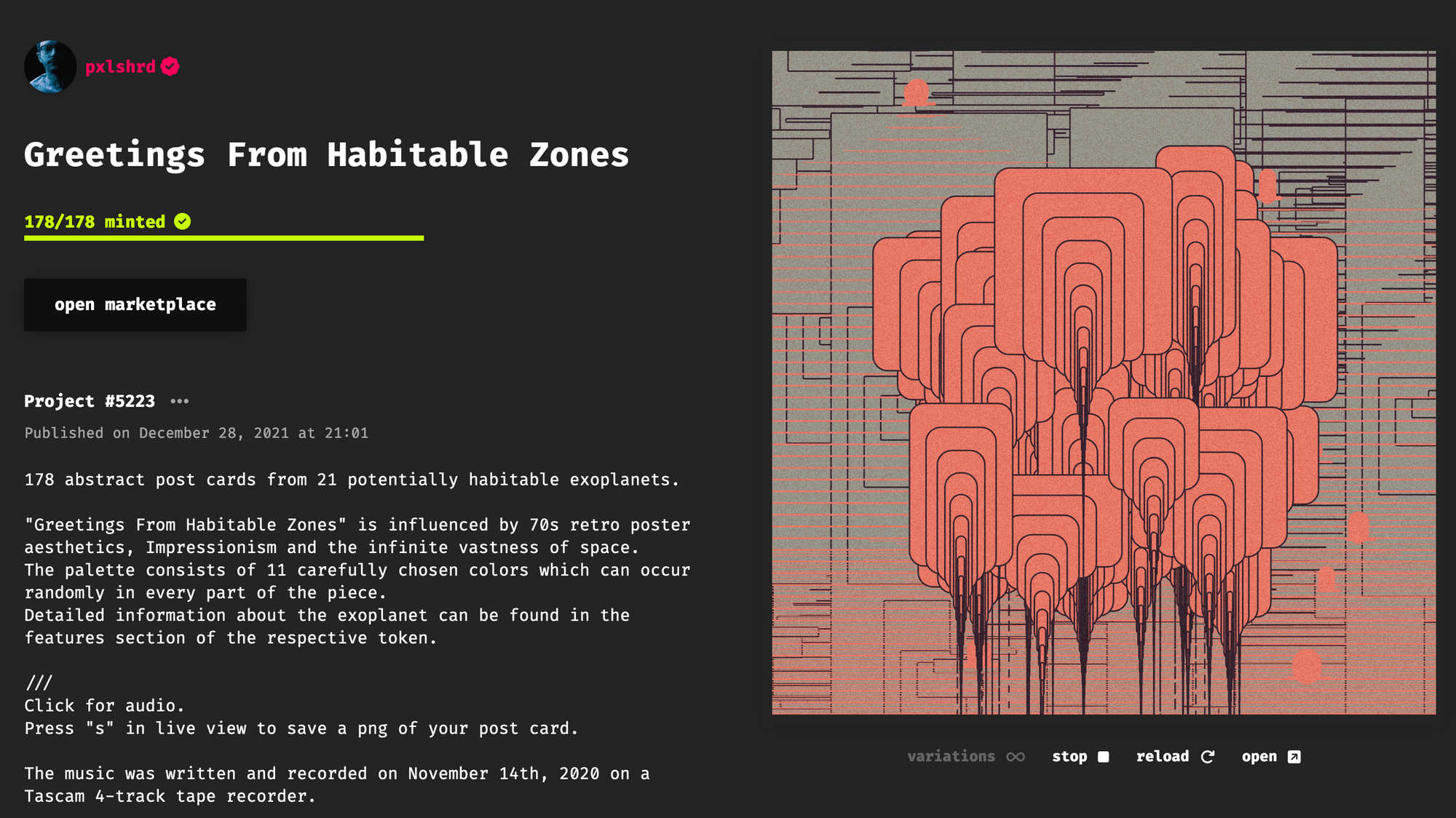
In my first projects I’ve used Hydra Synth for the animations and after a while I started making static pieces with p5js. Creating static pieces requires a clear and confident vision on how to best capture their essence - much like saying "here's the output, and that's what this piece is about", I find it beautiful to work in such a manner. It's just a completely different way of thinking about the meaning of a generative system.
GS: How did you discover fx(hash)? through Twitter?
It was a tweet or comment by ciphrd, a few days after fx(hash) had launched.
GS: At that point had you done any Tezos NFTs prior to that?
Yeah, I actually had a couple of different aliases back then for different things, one of them was headphaser where I did 3D stuff with Blender. There was absolutely no interest for it, although I was quite fond of them.
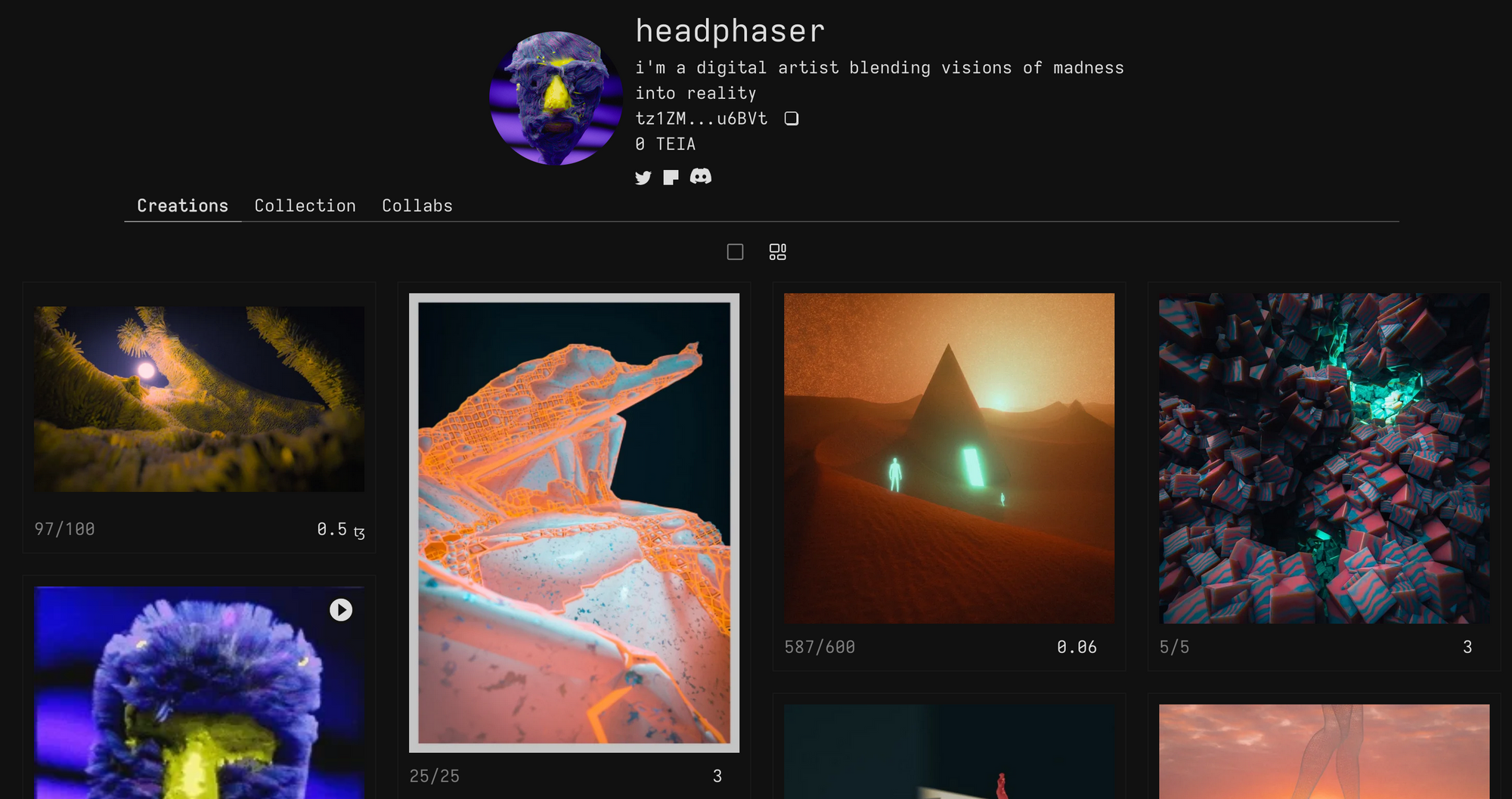
Now I don't do anything under that alias anymore. At that point, pxlshrd was just a side project for weird animated gifs.
GS: How did pxlshrd start? Did you learn coding just for fx(hash)?
PS: I knew about generative art, but I started coding with the launch of fx(hash).
GS: You've done an impressive number of projects in the short period of two years!
On Generative Music
GS: working as a sound engineer, you probably needed to know your way around computers. Have you ever attempted making generative music?
PS: I did dabble a little bit in generative music, experimenting with vcvrack - never with real euroracks - it was a fun experiment in Klangkunst (Sound Art), but it was hard for me to see it as real music. Though, I’ve used algorithmic composition in Indistinct Places. Initially intended as “loading screen music”, it became an essential part of the piece later in the process.
GS: Because it's not as structured as handcrafted compositions?
PS: That too - but mainly because I couldn't really express myself with scripted music, I need to have a guitar or keyboard in my hands, something that lets me directly interact with it and allows me to rely on my intuition.
GS: I understand what you mean - making music is a very emotionally engaged activity, with generative music you can't rely on intuition as much.
PS: Yeah exactly, it's very interesting but I don't see it as music - it feels more like visual scripting... but with sound.
GS: What do you think about Brian Eno's Music for Airports?
PS: I mean it's a classic, I never listened to it deeply - although I'm a big fan of ambient music. Most of the time I listen to tape ambient stuff, where you make use of tape loops, multiple tape machines and send recordings back and forth between them. There’s a tiny label called “Seil Records”. I really vibe with almost all of their releases.
GS: What do you think about AI-generated music? I've been noticing more and more AI-generated playlists popping up on YouTube.
PS: I actually experimented a bit with one of those AI music platforms a few weeks ago - typing in something like "Boards of Canada wobbly tape soundscapes" and I thought that the generated results were quite decent.
Although I haven't come across those playlists, I guess it's kinda cool - if you have a specific type of music in mind, just like Boards of Canada, and you want to hear more like it when there aren't really any other similar artists or tracks with the same vibe, you could just let AI generate it for you. But it's going to raise the same ethical questions just like AI-generated images did.
GS: One of my favorite artists is Tycho - there really isn't anything that comes close to his music.
PS: Yeah, i really like it too! Tycho's early stuff is very inspired by Boards of Canada, but it really is its own thing. I discovered Tycho’s first album like 20 years ago on MySpace [laughs]
GS: Another thing I'm curious about - I believe that there's a big overlap between coders and musicians. Many coders that I meet and talk to are also coincidentally musicians. Maybe it's a sort of confirmation bias, but I find that there's a lot of parallels between the two practices.
When you play an instrument, like the guitar or the keyboard, it's a very geometrical way of operating, that requires you to think about scales and patterns, which is not so different from generative art.
PS: There's a track by Boards of Canada titled "Music is math" - and music really is math, when you break it down.
Making music boils down to combining different sounds, selecting specific note sequences, and you end up making something bigger out of those components. It's similar in generative art, where you combine a variety of methods and different algorithms, and end up with something that is more than the sum of its parts.
But I don't think there is much difference in other creative practices, it's all based on the same foundation - on your experiences, what comes from the outside, and what it does with your mind and body - it all boils down to translating those ideas and feelings “onto paper” in a different way - so they're all just tools to express yourself.
GS: That's interesting, I haven't thought about drawing parallels to other creative practices.
Audible Mood Boards
GS: Let's backtrack a bit - when you minted your earliest works on fx(hash) why did you decide to do so alongside a musical track? Does the music add to the experience?
PS: When you put together music and visuals, it often opens up another dimension, giving rise to something that is more than the sum of the parts - and at the same time conjures a very specific feeling and/or mood.
I use this as a sort of vibe check to push my projects forward. Starting with an initial idea, which can be a feeling, a concept, something abstract like human behavior or even black holes in space - I then ask myself what would that sound like? while searching for music that aligns with this initial idea.
If it ends up reinforcing the feeling that I'm trying to convey, it usually is an indicator that I'm on the right track. It tends to be this back and forth between the visuals and the music, which drives the idea forward.
GS: On your portfolio, you have a bunch of spotify playlists, are those the tracks that you listen to while making your art?
PS: Exactly - I really enjoy putting together these playlists. They're quite varied, there's all kinds of genres on there. I also try to arrange them in a logical manner, such that the transitions from one track to the other somehow make sense.

GS: so overall your process tends to be more on the explorative side of things?
PS: I never have overarching concepts when I start out, because I find that to be too constraining. But you do need an initial idea, like a specific technique that you'd like to explore for instance. In the initial phase, it's really important that you're open to receiving any and every idea that might strike, without constraining yourself with some pre-conceived notions.
GS: In an article by Tyler Hobbs he states that one of the best things you can do, is to sit down and create new work, sometimes it's also okay if turns out to be garbage, after a few attempts you'll eventually find something interesting. So you try to explore and not force yourself too much.
PS: Exactly! Trying to be as intuitive as possible is really the best way to make something bigger. That reminds me of jam sessions with bandmates and friends, where we improvise on ideas and things just come out of intuition. Naturally, we would also record it so that we can listen back to it afterwards and use some fragments from those jams as foundations for writing new songs.

GS: Since you're bringing up the notion of improvisation - in Jazz for example, although you have a lot of freedom, at the same time it's still very structured, working inside of a structured framework that guides you. What are some of the things that help you stay on track with your projects?
PS: I have my toolbox of algorithms and techniques, like specific line drawing methods, that I've iterated on and that keep evolving with time. In a way that would be similar to the repertoire of a Jazz musician.
Backtracking a bit, the reason why I didn't start earlier with generative art was my assumption that code doesn't allow for an improvisational approach - intuition is really important to me - but after a while, I noticed that having a toolbox lends itself for that purpose.
GS: Do you think you'll make animated pieces with music again at some point in the future?
PS: I think about it all the time, but coding animations is just something so different. Every time I start on something, I lose interest really quickly. But I really love animated pieces - I'm a big fan of Kim Asendorf. I think his ability to grasp the "Zeitgeist" is unmatched.
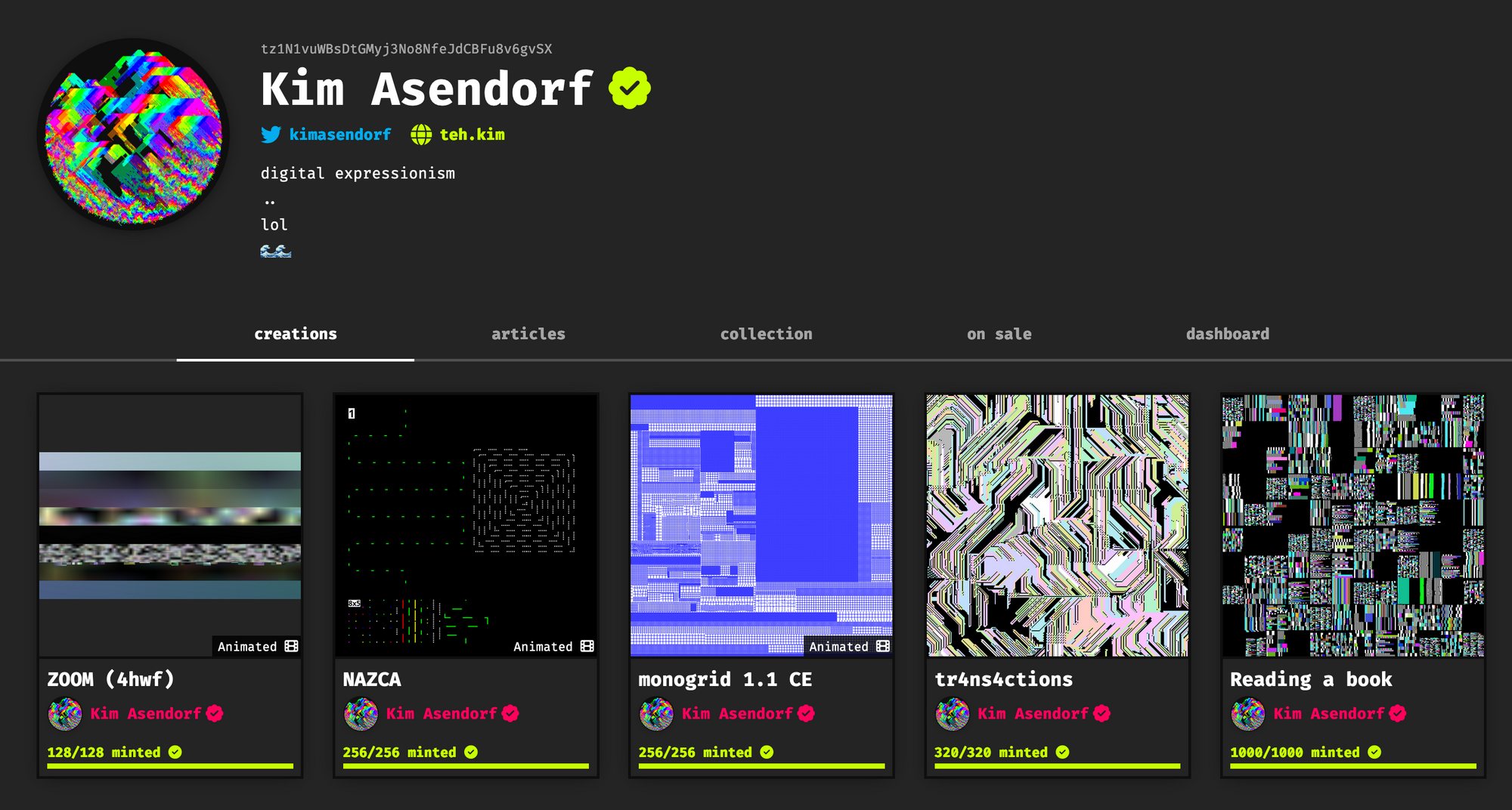
GS: Will you attempt something in that style at some point?
PS: Probably not, I'm more into organic-looking textures for my own animations.
The story behind Rückkopplung
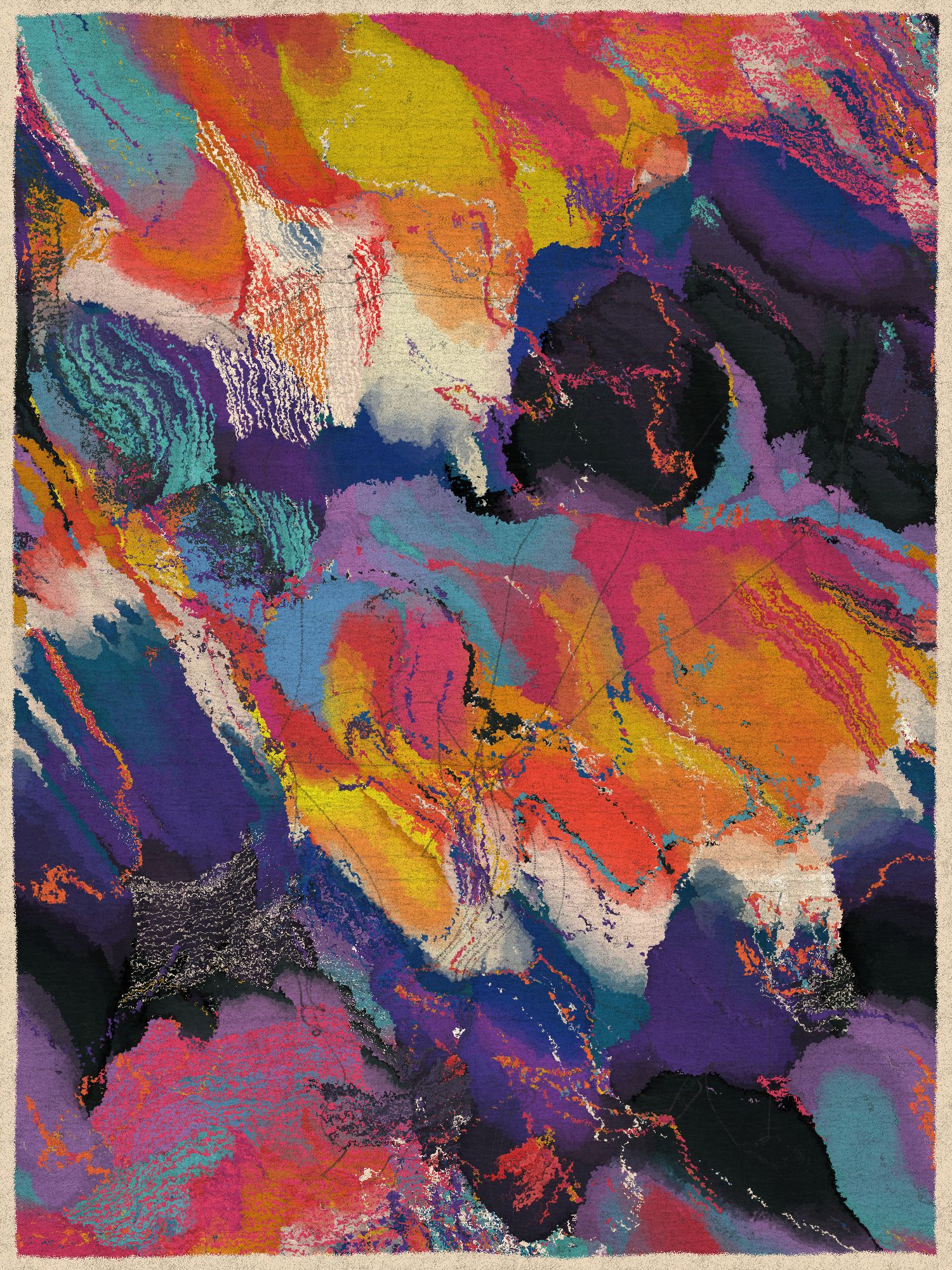
GS: You mentioned over on Twitter that you learned shaders for the purpose of Rückkopplung, how did that happen? Did you experiment with shaders prior to that?
PS: With Rückkopplung, I wanted to try my hand at abstract expressionism. The initial idea started with the canvas API, and the final project still heavily relies on it. But it bored me at some point because all outputs looked the same, so it didn't really make sense to me as a long-form piece - I put it aside and worked on other sketches that were more promising at the time.
It must've been my 50th or 60th attempt at using shaders, after having tried countless times before to no avail. I finally had a breakthrough and it clicked for me.
I was implementing something like a liquefy effect on another project and thought that it could work well with the Rückkopplung idea - to maybe give it a more painterly texture. So I did that, and the texture turned out really nice, but the initial problem remained where all of the outputs still looked the same. That really bothered me and in a fit of anger I started typing all sorts of things into the coordinates of the texture; adding in sines and tangent functions, and changing a bunch of variables.
Then I refreshed... and there was Rückkopplung!
I thought to myself "Wow, that's it!" - and the project had gone from a boring idea to 95% finished in just a few moments. The following months I simply worked on the micro-details and palettes.
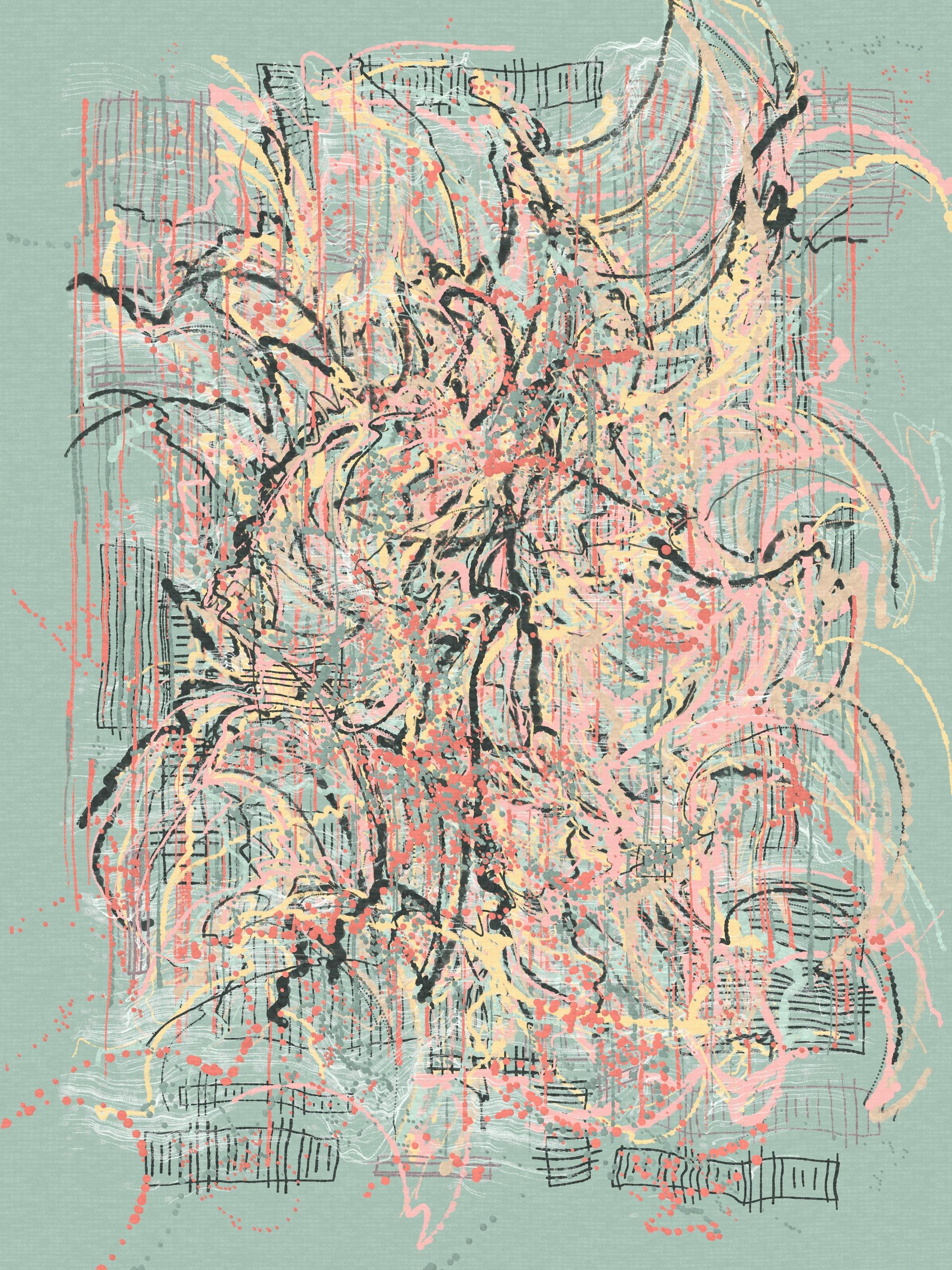
GS: At what point did the feedback effect come into play?
PS: That's actually the technique that I discovered during those couple of minutes!
GS: That's fascinating! I also really loved the description of the project, did the story evolve alongside the project?
PS: When the echoing patterns emerged after that magical moment, I didn't know what the piece was trying to tell me. It took a few weeks for me to fully grasp what it was reflecting. That’s the beauty of creating without boundaries - stuff just happens and only later do you unravel the workings of your subconscious.
Sometimes life feels like one big feedback loop. Your reactions to certain situations often follow a specific pattern, and you only become aware of this pattern once it repeats itself enough. You realize that it's something you've been doing your entire life, throughout similar kinds of situations.
You always tell yourself that the next time you'll react differently, but you never do, as if you're stuck inside of a feedback loop.
"Rückkopplung" translates from German as "feedback," and refers to the process wherein a system's output affects its input – creating a loop of influence that guides self-regulation and adaptation. When applied to the realm of human behavior, this feedback mechanism both reinforces the occurrence of patterns, and empowers us to evolve what is returned from the past - excerpt from Rückkopplung's description.
GS: That's beautiful; and I can relate - I've found myself in many peculiar situations, thinking to myself that I could have reacted differently, but then it happens again and I only realize when it's too late. It's frustrating, but such is human nature.

So in a way, making Rückkopplung was a little like therapy?
PS: All of my projects are - it's a bit egoistic, but each project is a way of processing something, or to find new meaning in things. I rarely talk about this in the descriptions or on Twitter (X), because most processes are just too personal. I try to let “the Art speak” and my audience decide what they see and feel. But this was my interpretation of the echoing patterns in Rückkopplung.
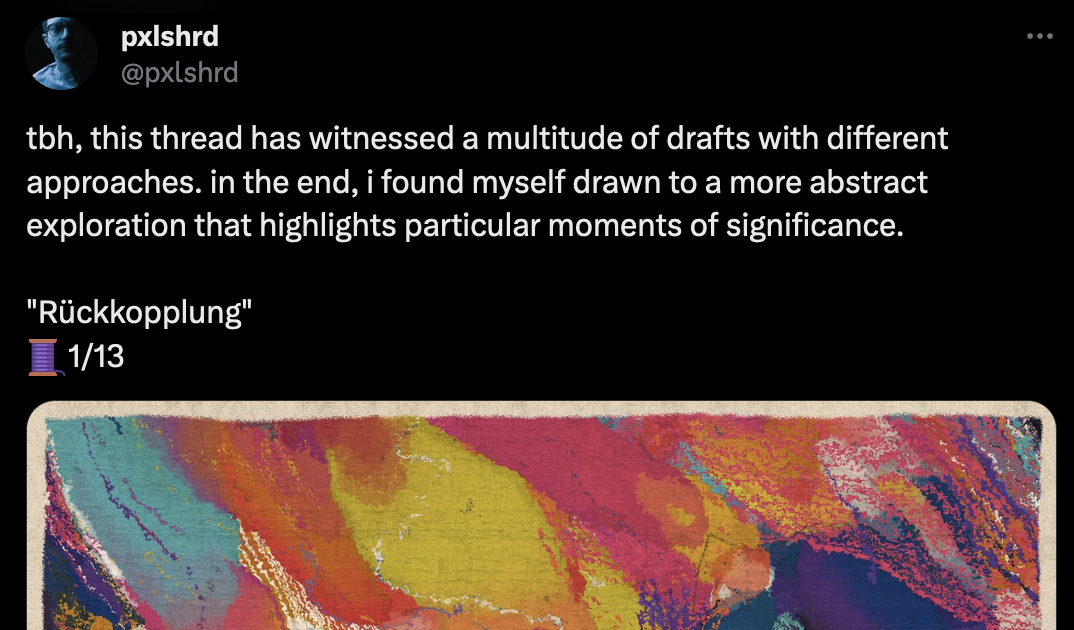
GS: The NFT space doesn't lend itself well to speaking out about personal problems that you might have in life. It generally tends to be toxicly positive.
What's more, is that you quickly get forgotten when you take a short mental health break from social media.
PS: It only takes a couple of days for people and the algorithm to forget about you.
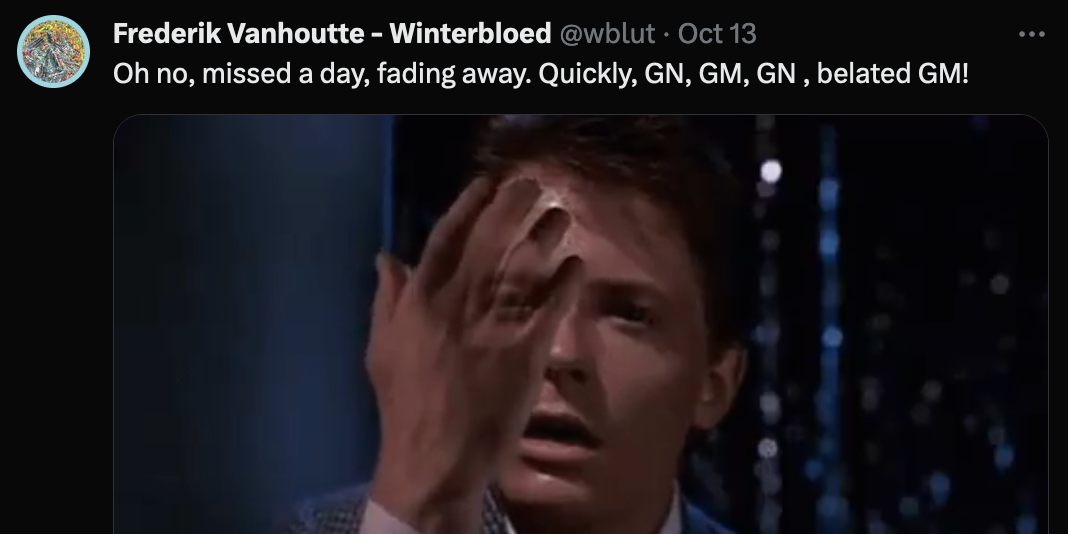
GS: You need to constantly feed the machine.
PS: In generative art we are at an advantage though, we always have some outputs to share.
Market Dynamics and the Value of Art
GS: Do you ever get influenced by market dynamics? If a token of yours sells out immediately, or if it doesn't sell out, does that influence how you view your art?
PS: For me these are two different worlds and I try to make a clear cut between them. The only thing I consider when I work on a long-form generative system is the edition size - I think about everything else once the creative work is finished.
Ultimately I'm still influenced in some way, anyway. But I generally don't make artistic decisions based on the market. I don't want to look back in the long-term and realize that I made decisions because of these external influences. It doesn't feel right to me.
GS: I can relate to that when it comes to edition sizes and burning unsold editions. I did burn editions of some of my earlier projects, but then I stopped because I don't see the point of artificially limiting the edition sizes.
Ok, you have to consider the secondary market - if there's un-minted editions it's automatically less valuable, and I understand that perspective, but to me it doesn't make my art less valuable. But maybe that's a dumb way of going about it if you want to be financially successful in the space.
PS: It's totally dumb [we both laugh] but ultimately you want to make art.
GS: The money is nice, but it's always primarily been about making art. It's a difficult topic.
PS: It is, it's not that I don't care. I want my collectors to also have some financial value with time, and I do my best to be a good artist - but ultimately it's not in my hand to decide what the market thinks about my art.
GS: I always believed in providing value through the writing that I do over on the blog, and the NFTs as a means to support that. My art only has the value that is contextually attributed to it, which can fluctuate a lot.
That's why I've always tried to provide value and give back in other ways, by means of informative and educative content.
PS: Yeah, i think that’s a great way of “giving value” to your works! Art is a very individual thing, the biggest value of Art to me is what it teaches me about myself and what I can convey through it to my audience. If my work manages to resonate with even one person or alter their way of thinking, then I’m truly the happiest person on Earth! To me that goes above and beyond its financial value.
Origin of pxlshrd and Shoutouts
GS: On the AB episode you had a lot of fun beating around the pronounciation of your artist name pxlshrd? Is it "pixel-shard" or "pixel-shred"?
PS: It actually was meant to be "pixel-shred", Ken from AB and Will from WTBS started pronouncing it as "pixel-shard", I really liked it, so I just went with that. But it doesn't matter to me [laughs]
GS: Finally, is there someone that you'd like to shoutout?
PS: Maybe a bit unusual but it would have to be Louis from the fx(hash) dev team. They’re always helpful, kind and find quick fixes for all kinds of bugs related to my fx(hash) projects. Just a gem of a human!
Closing Statement
Closing words from pxlshrd: Thanks a lot for having me and keep up the great work. I admire what you’re doing and it’s important that we have people like you in our little space!”
It was a pleasure talking to pxlshrd, and I'm grateful for the time he took out of his day to have this chat with me. Our conversation has definitely made me think about my approach to making generative art, even though I take a similar explorative approach to it, I seldomly take the time to look back and reflect on my creations. I think I should do that more often.
I also really feel like listening to some Tycho and Boards of Canada now.
And yet again, we find ourselves at the end of the article; here's the mandatory call to action - if you've reached and read this far, it most likely is an indicator that you've enjoyed this article - if you did, consider sharing it on your socials, with friends and followers, it helps tremendously and tells the algorithm that this is meaningful content.
Otherwise consider signing up to the newsletter to receive updates directly in your inbox whenever there's new content. That said, that's it from me - see you in the next one - cheers, and happy sketching - Gorilla Sun 🌸
